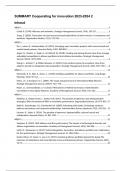SUMMARY Cooperating for innovation 2023-2024 2
Inhoud
WEEK 1.........................................................................................................................................................3
Gulati, R. (1998). Alliances and networks. Strategic Management Journal, 19(4), 293-317.....................3
Tsang, E. (2000). Transaction cost and resource-based explanations of joint ventures: A comparison and
synthesis. Organization Studies, 21(1), 215-242.......................................................................................4
WEEK 2.........................................................................................................................................................6
Du, J., Leten, B., Vanhaverbeke, W. (2014). Managing open innovation projects with science-based and
market-based partners. Research Policy, 43(5), 828-840..........................................................................6
Asgari, N., Tandon, V., Singh, K., & Mitchell, W. (2018). Creating and taming discord: How firms manage
embedded competition in alliance portfolios to limit alliance termination. Strategic Management
Journal, 39(12), 3273-3299.......................................................................................................................6
Stonig, J., Schmid, T., & Müller-Stewens, G. (2022). From product system to ecosystem: How firms
adapt to provide an integrated value proposition. Strategic Management Journal, 43(9),1927-1957.....8
WEEK 3.......................................................................................................................................................13
Heimeriks, K. H., Klijn, E., Reuer, J. J. (2009). Building capabilities for alliance portfolios. Long Range
Planning, 42(1), 96-114...........................................................................................................................13
Oxley, J. E., & Sampson, R. C. (2004). The scope and governance of international R&D alliances.
Strategic Management Journal, 25(8-9), 723–749..................................................................................15
Reuer, J.J., & Devarakonda, S. V. (2016). Mechanisms of Hybrid Governance: Administrative
Committees in Non-Equity Alliances. Academy of Management Journal, 59(2), 510–533.....................17
WEEK 4.......................................................................................................................................................17
Wadhwa, A., Bodas Freitas, I., Sarker, M.B. (2017). The paradox of openness and valueprotection
strategies: Effect of extramural R&D on innovative performance. Organization\Science, 28, 873–893..17
Katila R., Rosenberger J.D., Eisenhardt K.M. (2008). Swimming with sharks: Technology ventures,
defense mechanisms and corporate relationships. Administrative Science Quarterly, 53(2), 295-332...19
Laursen, K., Salter, A. (2014). The paradox of openness: Appropriability, external search and
collaboration. Research Policy, 43, 867–878...........................................................................................21
WEEK 5.......................................................................................................................................................21
Sampson, R. (2007). R&D alliances and firm performance: The impact of technological diversity and
alliance organization on innovation. Academy of Management Journal, 50(2), 364-386.......................21
Lahiri, N., Narayanan, S. (2013). Vertical integration, innovation, and alliance portfolio size: Implications
for firm performance. Strategic Management Journal, 34, 1042-1064...................................................23
Hoehn-Weiss, M., Karim, S., Lee, C-H. (2017). Examining alliance portfolios beyond the dyads:The
relevance of redundancy and nonuniformity across and between partners. Organization Science, 28(1),
56-73......................................................................................................................................................25
,WEEK 6.......................................................................................................................................................28
Keller, A., Lumineau, F., Mellewigt, T., & Ariño, A. (2021). Alliance governance mechanisms in the face
of disruption. Organization Science, 32(6), 1542-1570...........................................................................28
Malhotra, D., & Lumineau, F. (2011). Trust and collaboration in the aftermath of conflict: The effects of
contract structure. Academy of Management Journal, 54(5), 981-998..................................................32
Bottom, W. P., Gibson, K., Daniels, S. E., & Murnighan, J. K. (2002). When talk is not cheap: Substantive
penance and expressions of intent in rebuilding cooperation. Organization Science, 13(5), 497-513....34
SUMMARY Cooperating for innovation 2023-2024 2
2
,WEEK 1
Gulati, R. (1998). Alliances and networks. Strategic Management
Journal, 19(4), 293-317
5 key issues for the study of alliances:
1. The formation of alliances
2. The choice of governance structure
3. The dynamic evolution of alliances
4. The performance of alliances
5. The performance consequences for firms
Strategic alliances= Voluntary arrangements between firms involving exchange,
sharing or co-development of products, technologies or services
The social networks of prior ties not only affect the creation of new ties but also affected
their design, their evolutionary path and their ultimate success.
Embeddedness perspective= Highlights the significance of the social relationships in
which actors are situated for their future behavior and performance
By channeling information, social networks enable firms to discover new alliance
opportunities and can thus influence how often and with whom those firms enter into
alliances. Once two firms decide to enter an alliance, their relative proximity in the
network may influence the specific governance structure used to formalize the alliance.
The extent to which two partners are socially embedded can also influence their
subsequent behavior and affect the likely future success of the alliance. A firm’s portfolio
of alliances and its network position in an industry can have a profound influence on its
overall performance.
By examining the specific way in which social networks may constrain firms’ future
actions and channel opportunities, firms themselves can begin to take a more forward-
looking stance in the new ties they enter. They can be proactive in designing their
networks and con sidering the ramifications on their future choices of each new tie they
form. They may also selectively position themselves in networks to derive possible
control benefits as well.
3
, Tsang, E. (2000). Transaction cost and resource-based explanations of
joint ventures: A comparison and synthesis. Organization Studies,
21(1), 215-242.
4




